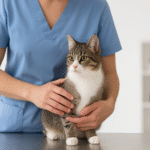Siamese cats are famous for their blue eyes, pointed coats, and talkative, people-loving personalities. But along with all that charm, this breed does come with a few health quirks—especially when it comes to their breathing. Siamese cats are more prone to respiratory issues than many other breeds, which can leave owners worried when they hear coughing, wheezing, or congestion.
The good news? With the right knowledge and care, most respiratory conditions can be managed so your Siamese can live a long, happy life. Let’s look at why this breed is more vulnerable, the most common problems you may encounter, and what you can do at home to help your cat breathe easier.
Why Siamese Cats Are Prone to Respiratory Problems
Siamese cats don’t get sick just because of who they are, but their unique genetics and body structure do put them at higher risk than many other breeds. Selective breeding for their trademark looks—slender bodies, wedge-shaped heads, and striking pointed coats—has also passed along traits that make breathing a little more complicated.
One factor is their anatomy. Siamese cats often have narrow nasal passages and elongated heads, which can restrict airflow and make them more prone to noisy breathing or congestion. Add in their sensitive immune systems, which tend to overreact to harmless things like dust or pollen, and you’ve got a recipe for frequent respiratory flare-ups.
Common Respiratory Conditions in Siamese Cats
Asthma. Siamese cats are more likely than other breeds to develop asthma, a condition where the airways become inflamed and narrow. At home, you might notice coughing that sounds almost like gagging, wheezing, or rapid breathing. With proper treatment—usually inhalers or oral medications—most asthmatic cats go on to live full, active lives.
Rhinitis. If your Siamese seems stuffy, sneezes a lot, or has nasal discharge, rhinitis may be the culprit. This condition happens when the nasal passages become inflamed, often due to allergies, viral infections, or even dental issues. Some cases are temporary, while others require long-term management with antihistamines or antibiotics.
Bronchitis. Both short-term and chronic bronchitis can affect Siamese cats. Symptoms often look like a dry, hacking cough or labored breathing. Because it overlaps with asthma, your vet may run extra tests to figure out which condition is causing the symptoms. In either case, medication and lifestyle adjustments usually help bring relief.
Pneumonia. Though less common, pneumonia can occur if infections move deeper into the lungs. This is a serious condition that causes fever, lethargy, and severe breathing problems. If your Siamese ever seems weak, hot to the touch, and is struggling to breathe, it’s an emergency that needs immediate veterinary attention.
Laryngitis. Siamese cats are known for their chatty voices, so if yours suddenly sounds hoarse or raspy, it may be laryngitis. This irritation of the voice box can be caused by viral infections, allergens, or even overuse of their vocal cords. Most mild cases heal with rest, though persistent or severe cases need a vet check.

How to Help Prevent Respiratory Problems
You can’t change your Siamese’s genetics, but you can make their environment healthier and reduce the triggers that set off breathing problems. Small changes at home add up to big benefits for their long-term health.
- Stay current with vaccines. Core vaccines help protect against viruses that cause upper respiratory infections. Ask your vet about optional vaccines if your cat is at higher risk.
- Cut down on irritants. Cigarette smoke, scented candles, and strong cleaning sprays can all irritate sensitive airways. Air purifiers and regular vacuuming go a long way in helping Siamese cats breathe easier.
- Feed for health. A balanced diet with plenty of protein supports a strong immune system. Keeping your cat at a healthy weight is also key, since obesity puts extra strain on the lungs.
- Reduce stress. Cats are sensitive to routine changes and loud environments. Stress can weaken their immune system, making respiratory issues more likely to flare up.
- Act quickly. Don’t wait if your cat starts wheezing, coughing, or struggling to breathe. Early treatment almost always leads to better outcomes.
Final Thoughts
Siamese cats may have a higher chance of developing respiratory problems, but that doesn’t mean they can’t enjoy a long, active, and happy life. With a watchful eye, the right environment, and prompt veterinary care, most Siamese bounce back quickly from flare-ups and continue being the lively, affectionate companions we love.
Owning a Siamese means embracing their quirks—the endless chatter, the curiosity, and yes, even the occasional sneeze or cough. With your care and attention, they’ll reward you with years of loyalty, playfulness, and love.






